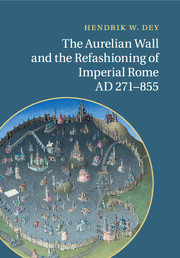Book contents
- Frontmatter
- Contents
- List of abbreviations
- List of figures
- Acknowledgements
- Introduction
- 1 Toward an architectural history of the Aurelian Wall, from its beginnings through the ninth century
- 2 Planning, building, rebuilding, and maintenance: the logistical dynamics of a (nearly) interminable project
- 3 Motives, meaning, and context: the Aurelian Wall and the late Roman state
- 4 The city, the suburbs, and the Wall: the rise of a topographical institution
- 5 Sacred geography, interrupted
- 6 The Wall and the “Republic of St. Peter”
- Conclusion
- Appendices
- Appendix A Numerical data
- Appendix B The fourth century revisited: the problem of Maxentius
- Appendix C The post-Honorian additions to the Porta Appia and other fifth- and sixth-century construction
- Appendix D The Aurelian Wall and the refashioning of the western tip of the Campus Martius
- Appendix E The Pons Agrippae and the Pons Aureli: a tale of two bridges
- Bibliography
- Index
Appendix C - The post-Honorian additions to the Porta Appia and other fifth- and sixth-century construction
Published online by Cambridge University Press: 19 May 2011
- Frontmatter
- Contents
- List of abbreviations
- List of figures
- Acknowledgements
- Introduction
- 1 Toward an architectural history of the Aurelian Wall, from its beginnings through the ninth century
- 2 Planning, building, rebuilding, and maintenance: the logistical dynamics of a (nearly) interminable project
- 3 Motives, meaning, and context: the Aurelian Wall and the late Roman state
- 4 The city, the suburbs, and the Wall: the rise of a topographical institution
- 5 Sacred geography, interrupted
- 6 The Wall and the “Republic of St. Peter”
- Conclusion
- Appendices
- Appendix A Numerical data
- Appendix B The fourth century revisited: the problem of Maxentius
- Appendix C The post-Honorian additions to the Porta Appia and other fifth- and sixth-century construction
- Appendix D The Aurelian Wall and the refashioning of the western tip of the Campus Martius
- Appendix E The Pons Agrippae and the Pons Aureli: a tale of two bridges
- Bibliography
- Index
Summary
While a precise chronology for the post-Honorian additions to the Porta Appia is difficult, a few remarks may be hazarded.
As others have said, the foundations of the Honorian towers subsided rather dramatically at an early date, destabilizing them dangerously and opening large fissures in their exteriors, some of which were extensively repaired in the 1920s. It has thus been suggested that the additions to the towers were meant to buttress them, tempting some to connect their construction with damage sustained in the earthquake of 443. This hypothesis is not without its problems, however. To begin with, its proponents assert that the new top chambers were added after the “buttresses”; yet if the towers were unstable enough already to require buttressing, it is hardly probable that they would subsequently have been singled out, as very few towers anywhere along the Wall were, for further heightening. More importantly, similar square shells were added around Honorian towers at three other gates, the Portae Flaminia, Tiburtina, and Praenestina-Labicana, none of which seems to have been affected by serious problems with subsidence, earthquake-related or otherwise.
The fact remains that both the square casings and the top chambers do appear to have been added after the gate had suffered significant damage, consonant with what an earthquake might be expected to provoke. The year 443 thus remains a possible terminus post quem; but as it seems unlikely that reconstruction on such a grandiose scale was undertaken during the turbulent years between the sack of Rome in 410 and the end of the fifth century, I am inclined to move the terminus post to the period of Theoderic, the first ruler after Honorius to whom significant work on the Wall can be credited, during whose reign another powerful earthquake shook the city, in 502.
- Type
- Chapter
- Information
- Publisher: Cambridge University PressPrint publication year: 2011



